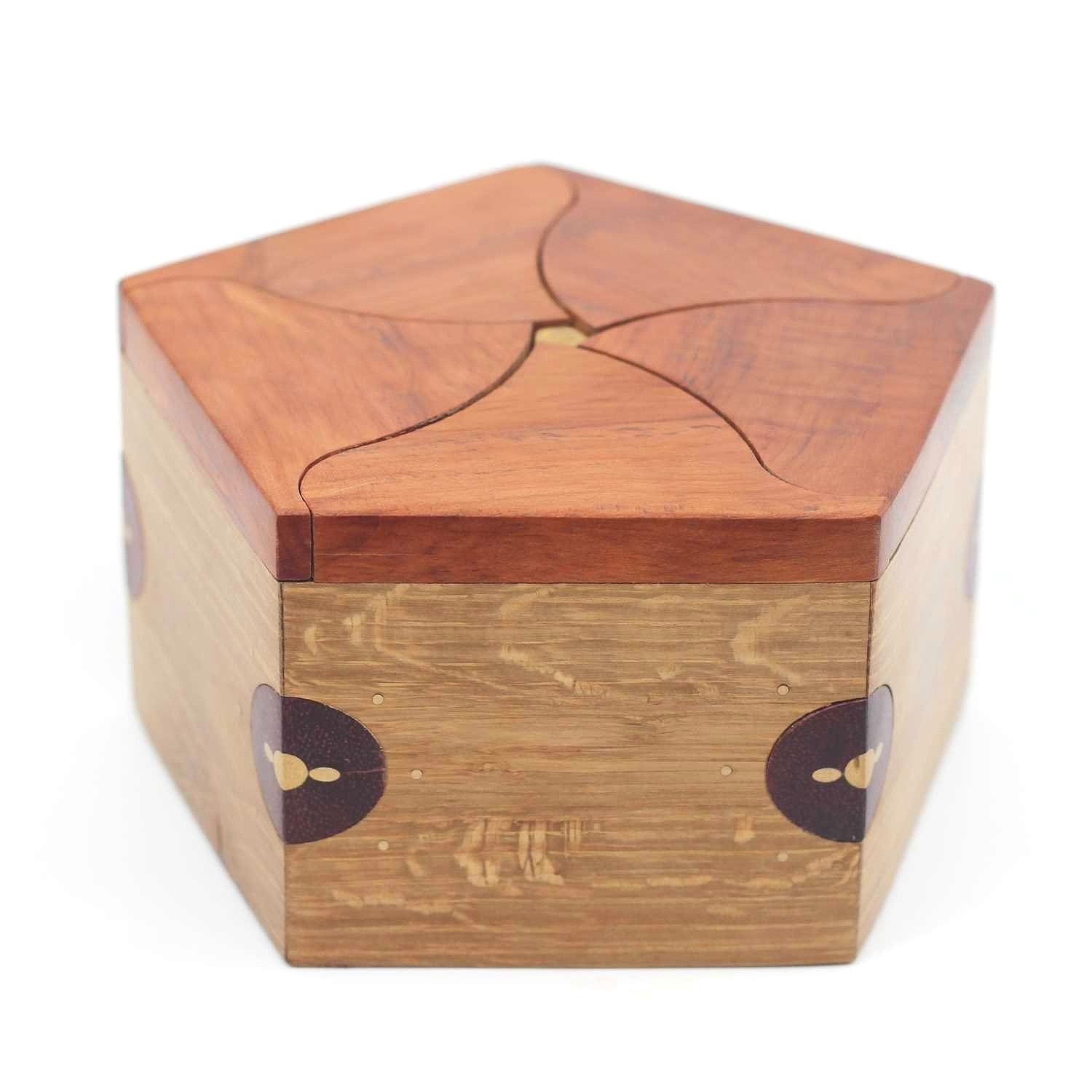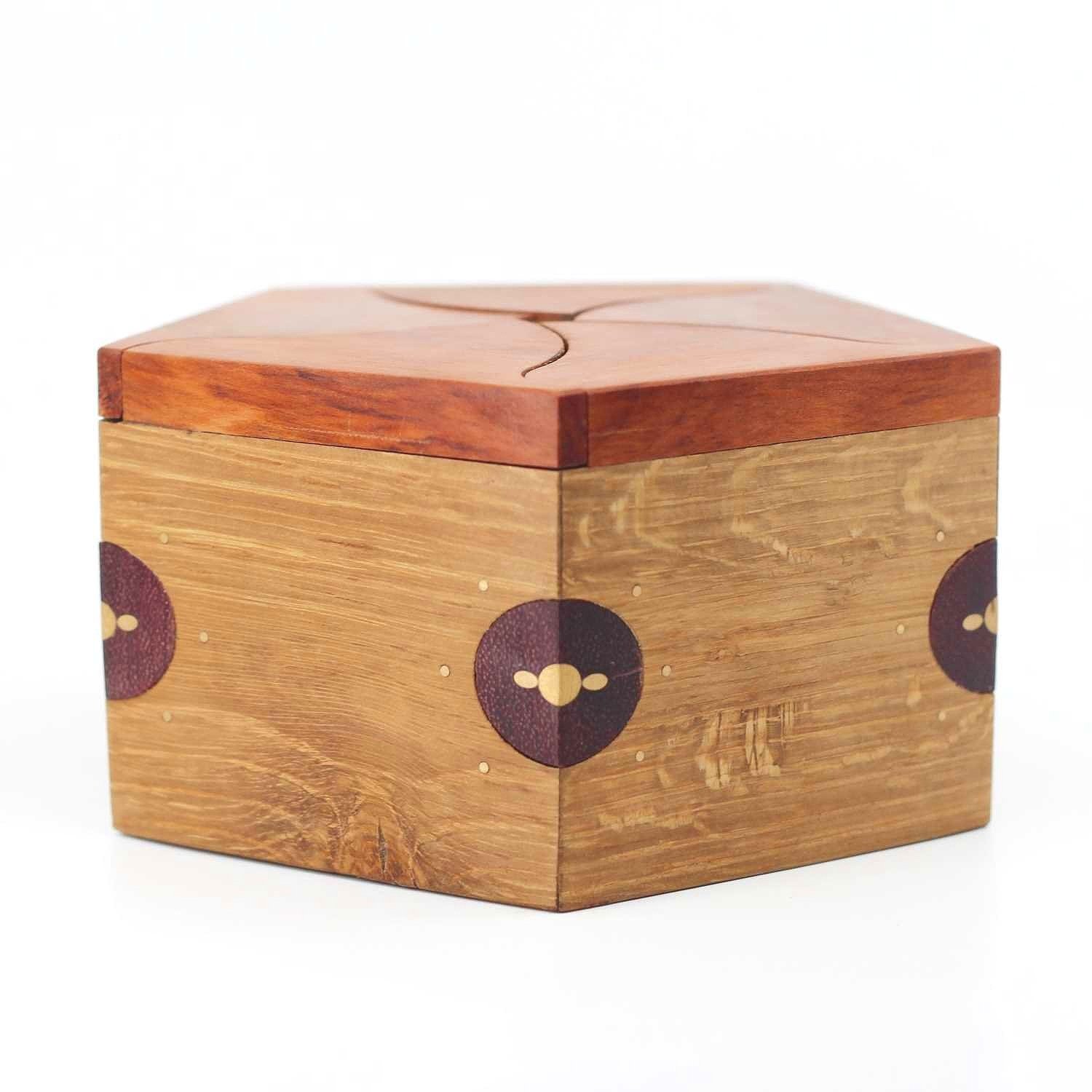Transformation
Petal Box
Dod Yn Ol At Fy Nghoed (Welsh phrase - “To return to a balanced state of mind”; literally, “to return to my trees”)
Welsh environmental architect Peter Canham makes beautiful objects. When he’s not constructing tree house dwellings in the enchanted forests of Wales (returning to his trees), or building secret gin and cocktail bars in the woods for festivals in the trees, he is never far from the trees. He has a playful and creative mind perfectly suited for puzzle making, and he likes to infuse a sense of magic and place into his work. His Petal Box is one of his loveliest creations and embodies the spirit of his home in so many ways.
Petal Box by Peter Canham
Peter explains: “So the Petal box is all about transformation. Last year I started to notice a few plants in and around my garden and the woods that transformed on daily basis, moving and changing with the sun, specifically the chicory and daisy flower. Both of these flower heads close at night and then open again in the morning, in fact in Welsh the common daisy is called “llygad y dydd” (tricky to say but the double LL is a sound you make when you put your tongue on the roof of your mouth and blow and the double DD is like a ‘th’) which means “eyes of the day”.
beguiling bouquet
The petal box grew from this. I started making prototypes which opened and unfurled many doors at once like a flower, some successful some still developing. I wanted the petals to open without being directly interacted with (although the box can be opened that way once solved) so the mechanism was designed to allow the puzzler to get that wow moment of the petals opening, almost, by themselves. The shapes and detail of the box are designed to represent, in an abstract way, the details of plants, the stamen, stigma, petals and seeds.”
flower power
I find this particular Petal Box of Peter’s particularly beautiful and meaningful thanks to the stunning wood choices he has used in the construction. It’s made from Welsh Oak, Hawthorn, Purple Heart, Birch with Bog Oak and has brass details. Most of these woods have a story of their own. “The petals, bottom and trim are all made from Hawthorn. It’s a tree that grows all around Wales and the UK in hedgerows and woodland borders. Hawthorn doesn’t get that big and grows slowly with many twists and turns so it’s not that easy to get descent sized bits out, this piece came from a really mature tree on a local farm that was taken from a hedgerow. The body is from a lovely big old Oak that was growing a stones throw from my front door. Unfortunately this Oak blew down in a big storm (the base had started to hollow out) and I brought in a mobile mill to plank it up. It was a good 4-500 years old so had had a good long life, now to have new life as boxes and furniture.” The Bog Oak accents on the box are also special, from a 500 year old piece of wood Peter pulled from the bog himself – the same wood he used in his sensational Ripple Box.
llygad y dydd
Petal Box is also not just a pretty box – it’s a very nice puzzle and lives up to the seeds of expectations planted by all these descriptions. There are at least eight well designed moves required and a degree of deeper understanding needed to open the box. The piece is dynamic, and transforms more than once as you open it, culminating in the promised satisfying spectacle. Peter has worked his own magic here in giving new life to this old wood.
Rose Petal
The classic “flower petal” cocktail is certainly the Daisy, a simple citrus sour which goes back well over a century and has many interpretations. The Brandy Daisy can be found in the pages of the father of mixology, “Professor” Jerry Thomas’s The Bartenders Guide or How To Mix Drinks: The Bon-Vivants Companion, 1876, where the curious instructions to mix 3 or 4 dashes of gum syrup, 2 or 3 dashes of Curaçao liqueur, the juice of half a small lemon, 1 small wine-glass of brandy and 2 dashes of Jamaica rum, served over shaved ice and topped with seltzer, are to be found. Over time the base spirits have changed, depending on the times, like the popular Gin Daisy of the 1930s. Herbal yellow Chartreuse is often included, lemon may be exchanged for orange, and grenadine is likely to replace the simple syrup for sweetness. The Daisy gave way to more recognizable classics like the Side Car, and of course, the Margarita (which means daisy in Spanish).
a rosy disposition
But I haven’t made a Daisy. This flower petal grew organically as I built it, and after various iterations and ingredients became a rosy and sweet variation on the Negroni (not very surprising, since that is one of my favorite cocktails and templates). The drink features a gin base, which is a great way to anchor a floral cocktail, and the classic spirit in a Negroni. To that is added the lightly bitter aperitif Cocchi Rosa and the mild red bitter amaro Capaletti. Cocchi Americano is an aromatized wine from the Italian town of Asti, originally formulated in 1891. The bottles feature a futuristic rooster (designed in 1930) which symbolizes the awakening of the appetite (the true purpose of an aperitif). The Rosa formula uses a Piedmont red wine infused with gentian, cinchona, citrus zests and rose petals and has a lightly bitter and sweetly floral flavor. Capaletti is another Italian spirit, a classic red bitter produced in the Trento hillside region. It is equally intriguing but less sweet than the well known Campari and brings more balance to this cocktail. A dash of lime bitters ties it all together for a very nice experience. Next time you are bringing flowers to someone, you might try this bunch. Cheers!
A pair in bloom
Rose Petal
1 oz gin
1 oz Cocchi Rosa
1 oz Capaletti
2 dashes lime bitters
Stir ingredients with ice and strain into a favorite glass over a large cube. Lime twist (or petal wheel) garnish.
Explore more:







